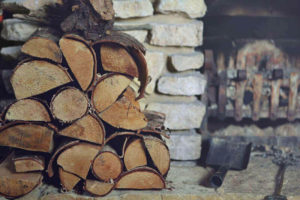If you’re planning to burn a wood fire this year, you should already be preparing your firewood. When it comes to wood heat, you have to give your fuel a period of time before it’s suitable for burning. If your wood is not ready when fall arrives, your fire may be more difficult to light, it will require more wood to reach a desired temperature, and your fire will produce more soot and creosote that will coat your flue. Avoid these issues and more by making sure your firewood is ready for fall.
Choosing Your Firewood
It may seem that if you have your own supply of trees, then you have ample firewood. This is not always the case. What type of wood you use, can determine how much you need and how well it heats, and for how long. Hardwoods like hickory, oak, and rock elm have more energy output per cord of firewood, thus heating better. Softer woods like pines, spruce, and balsam burn faster and do not produce a long-lasting bed of coals or long-lasting heat. Hard woods may be ideal, but there are many regions in the U.S. where homes have been heated solely by softwoods and they stay warm.
Preparing Your Firewood
When you cut your firewood, it is filled with water up to 80 percent. This water will make it very difficult to burn. At this point the wood is “green” or “wet”. The wood is not suitable for burning until it reaches a 30 percent moisture content. At this point it is considered “seasoned”. How do you get from green to seasoned? You wait. First, cut your tree, and then cut the tree into pieces so that air can get to the inside and help the tiny tubes full of water to dry. Splitting your firewood will help it season even faster.
Storing Your Firewood
Once you split your firewood, you want to store it in loose stacks so that air can circulate around the wood. This way it continues to dry while you wait for winter. Closing the wood tightly into a wood shed will not allow it to adequately dry. Instead, consider stacking your firewood on a bed of gravel so that water runs off. Pile it bark-side up so that water runs off of the pile, and the wind and sun can help to dry the wood internally. It’s not necessary to even cover the wood, because it should dry in six months or a little longer for harder woods.
Buying Seasoned Firewood
When buying firewood, you should still make certain it’s ready to burn. You can identify properly seasoned wood by looking for these signs:
-Dull in color
-Cracks or checks in the wood
-Light in weight
-Hollow-sounding when hit together
-Bark pulls away
If you’re not sure about your firewood, it’s best to talk to a professional about all of your chimney and fire needs. At New Buck Chimney Services a fire expert can speak with you by phone or appointment. Call today at 318-674-2825 or schedule online.

